AI4T: synopsis of the IAI MOOC
Info:
This presentation has been realized as part of the European project AI4T to introduce and explain the objectives of the Class’Code & Inria IAI MOOC to the European partners. To this end, a shortened version in English is presented.
This short version was produced by Inria Learning Lab in March 2021, based on the French version of the MOOC, which is running on the FUN platform since April 2020: “L’Intelligence Artificielle… avec intelligence !”
Presentation of the MOOC “Artificial Intelligence … with intelligence !”

About the MOOC
Are you afraid of AI? Have you heard about it in everyday life? Humans would be good for the scrap yard? What is (artificial) intelligence by the way? Class’Code & Inria IAI MOOC is a citizen MOOC open to everyone from 7 to 107 years old to question, to experiment and to understand what is Artificial Intelligence… with intelligence!
The objective of this MOOC is to:
- decrypt the language around AI in order to move from preconceived ideas to questions that can be used as a basis for understanding,
- manipulate AI programs in order to make your own opinion,
- share a minimal culture on the subject, to become familiar with the subject beyond preconceived ideas,
- be able to discuss the subject, its applications, its framework with various interlocutors in order to contribute to the construction of AI applications.
Who is this MOOC for?
The training is aimed at everyone and more specifically to:
- Education professionals (teachers, educators, facilitators),
- Young people aged 7 to 17 using the provided materials,
- Citizens who want to understand what is being talked about in order to contribute to the debate.
Evaluation
- Self-assessment through quizzes or exercises throughout the MOOC sequences,
- Peer-evaluated activity,
- Certificates of successful completion issued by FUN.
The MOOC is organized in 3 modules:
 Module 1 : Did you say AI? What is artificial intelligence?
Module 1 : Did you say AI? What is artificial intelligence?
This first part is dedicated to the acquisition of a first understanding of what is meant by Artificial Intelligence, what it is not and finally raises the question: what is intelligence?
 Prerequisites : none
Prerequisites : none  Investment time: 2h – 2h30 or more with the resources
Investment time: 2h – 2h30 or more with the resources
 3 videos (11’26”)
3 videos (11’26”)  5 activity sheets
5 activity sheets  1 Educational game
1 Educational game
 2 Quizzes/hands-on exercises
2 Quizzes/hands-on exercises  Resources to go further
Resources to go further
 Module 2 : Boosted with AI! Machine learning and data
Module 2 : Boosted with AI! Machine learning and data
This second part helps to understand the basics of machine learning and the key role played by the control of data sets.
 Prerequisites : none
Prerequisites : none  Investment time: 2h – 2h30 or more with the resources
Investment time: 2h – 2h30 or more with the resources
 4 videos (21’39”)
4 videos (21’39”)  6 activity sheets
6 activity sheets  1 Educational game
1 Educational game
 2 Quizzes/hands-on exercises
2 Quizzes/hands-on exercises  Resources to go further
Resources to go further
 Module 3 : Humans and AI: Artificial intelligence at our service?
Module 3 : Humans and AI: Artificial intelligence at our service?
This third part deals with ethical issues and aims at understanding the challenges and levers for AI to be at the service of humans.
 Prerequisites : none
Prerequisites : none  Investment time: 2h – 2h30 or more with the resources
Investment time: 2h – 2h30 or more with the resources
 3 videos (9’50”)
3 videos (9’50”)  3 activity sheets
3 activity sheets  1 Educational game
1 Educational game
 2 Quizzes/hands-on exercises
2 Quizzes/hands-on exercises  Resources to go further
Resources to go further
Each module is built in 4 steps:
- To question yourself: to move from preconceived ideas to questions that can be used to understand.
- To experiment: to carry out a connected or unplugged activity and discover for oneself.
- To discover: to understand how things work through the history of humans and their ideas.
- To debate: to be able to discuss the subject, its applications, its framework with various interlocutors to contribute to the construction of AI applications.
Course outline
Opening module of the MOOC
Objective: To present the entire training program with its objectives, contributors, editorial choices and evaluation.
- Why this MOOC?
- Who contributed to this MOOC?
- What does this course contain? How is it organized?
- Exercises: how to get a certificate?
An invitation to learners to introduce themselves on the MOOC forum is made at the beginning of the course in order to encourage them to invest in a community of sharing and mutual aid on which the teaching team relies to complete, feed and develop the course content according to their needs.
Module 1 : Did you say AI?
Objective: To acquire a first understanding of what is meant by AI and what it is not.
|
|
|
1.0 Introduction to Module 1
|
 Detailed outline of Module 1 Detailed outline of Module 1
The detailed outline gives access to the list of the 6 sequences of the module and their resources.
The resources are different types of media: videos, tutorials, texts, activity sheets, educational games, list of external resources to go further, quizzes and hands-on exercises.
Below, we have selected some of the resources of Module 1, as an example of the different types of contents of the MOOC. |
|
1.1 To question yourself: Who is afraid of AI?
|
|
| Educational objectives
At the end of this sequence, learners will be able to :
- get oriented in the history of AI: birth, milestones
- differentiate between biological and artificial intelligence
- develop a critical thinking on the discourses around AI carried by the media, especially concerning the so-called strong AI.
|

Example of introductive video
|
|
1.2 To experiment: let’s test our first program
|
|
| Educational objectives: Technical notions will be discovered by concretely manipulating digital objects, and by learning to explain how to manipulate them. |
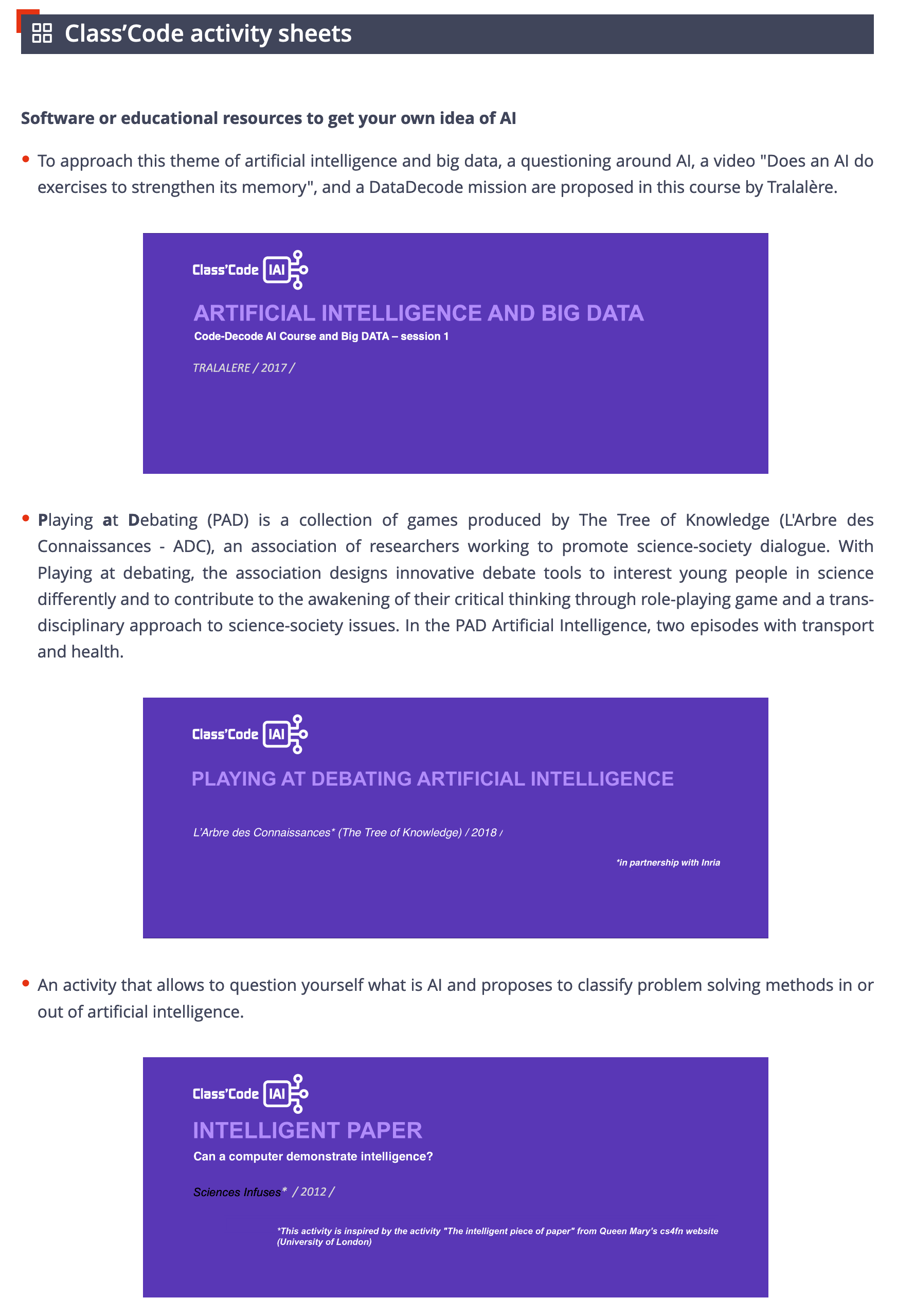
Example of activity sheet
|
|
1.3 To discover: What is artificial intelligence?
|
|
| Educational objectives
At the end of this sequence, learners will be able to:
- develop critical thinking skills and discuss the concept of intelligence,
- describe the two main approaches to AI: symbolic/digital,
- question the “AI” tool and what we do with it.
|
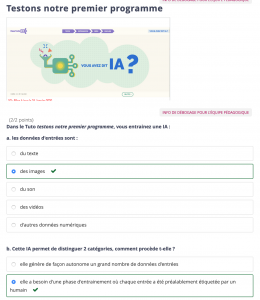
Example of hands-on exercise
|
|
1.4 To debate: AI in all its aspects
|
|
Educational objectives
At the end of this sequence, learners will be able to:
- To give a voice and to bring together AI designers (scientific, industrial) and users (citizens, professionals)
with a special Education slot each time
- Conferences in face-to-face or webinars
|
|
|
1.5 Summative evaluation at the end of the module: Quiz Module 1
Educational objective: summative evaluation on the theoretical concepts seen here in Module 1. |
|
|
1.6 Summative evaluation at the end of the module: AI to play with! Questions
Educational objective: summative evaluation on the hands-on activities seen here in Module 1. |
|
Module 2. Boosted with AI! Machine learning and data
Objective: To understand the principles of machine learning and the key role played by the control of data sets.
|
|
|
2.0 Introduction to Module 2
|
 Detailed outline of Module 2 Detailed outline of Module 2
The detailed outline gives access to the list of the 6 sequences of the module and their resources.
The resources are different types of media: videos, tutorials, texts, activity sheets, educational games, list of external resources to go further, quizzes and hands-on exercises.
Below, we have selected some of the resources of Module 2, as an example of the different types of contents of the MOOC.
|
|
2.1 To question yourself: AI in all its aspects
|
|
| Educational objectives
At the end of this sequence, learners will be able to:
- question the “AI” tool and what we can do with it
- describe the concept of machine learning
- explain the difference between a recognition system and a prediction system
|
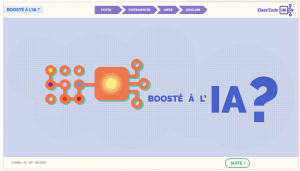
Example of a tuto video
|
|
2.2 To experiment: Let’s play with data
|
|
| Educational objectives
At the end of this sequence, learners will be able to:
- develop critical thinking skills about the origin of learning data
- determine how to properly prepare a dataset
- describe the notion of artificial neural networks
|
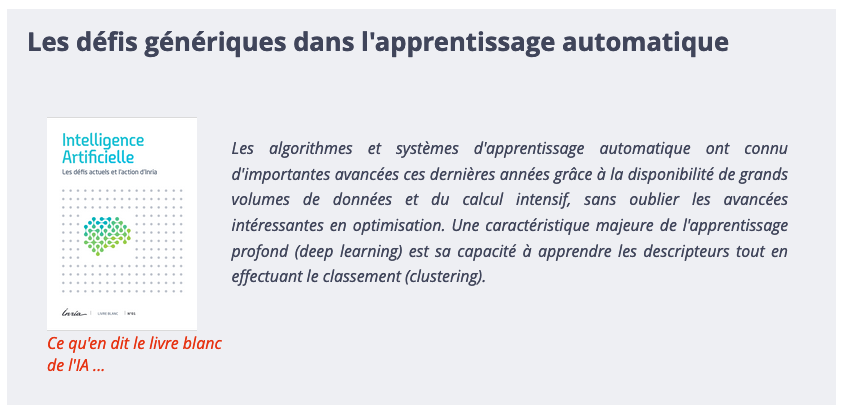
Example of a text resource: Inria’s AI White Paper
|
|
2.3 To discover: Machine learning and data
|
|
| Educational objectives
At the end of this sequence, learners will be able to:
- explain how machine learning works
- develop the notion of deep learning
|
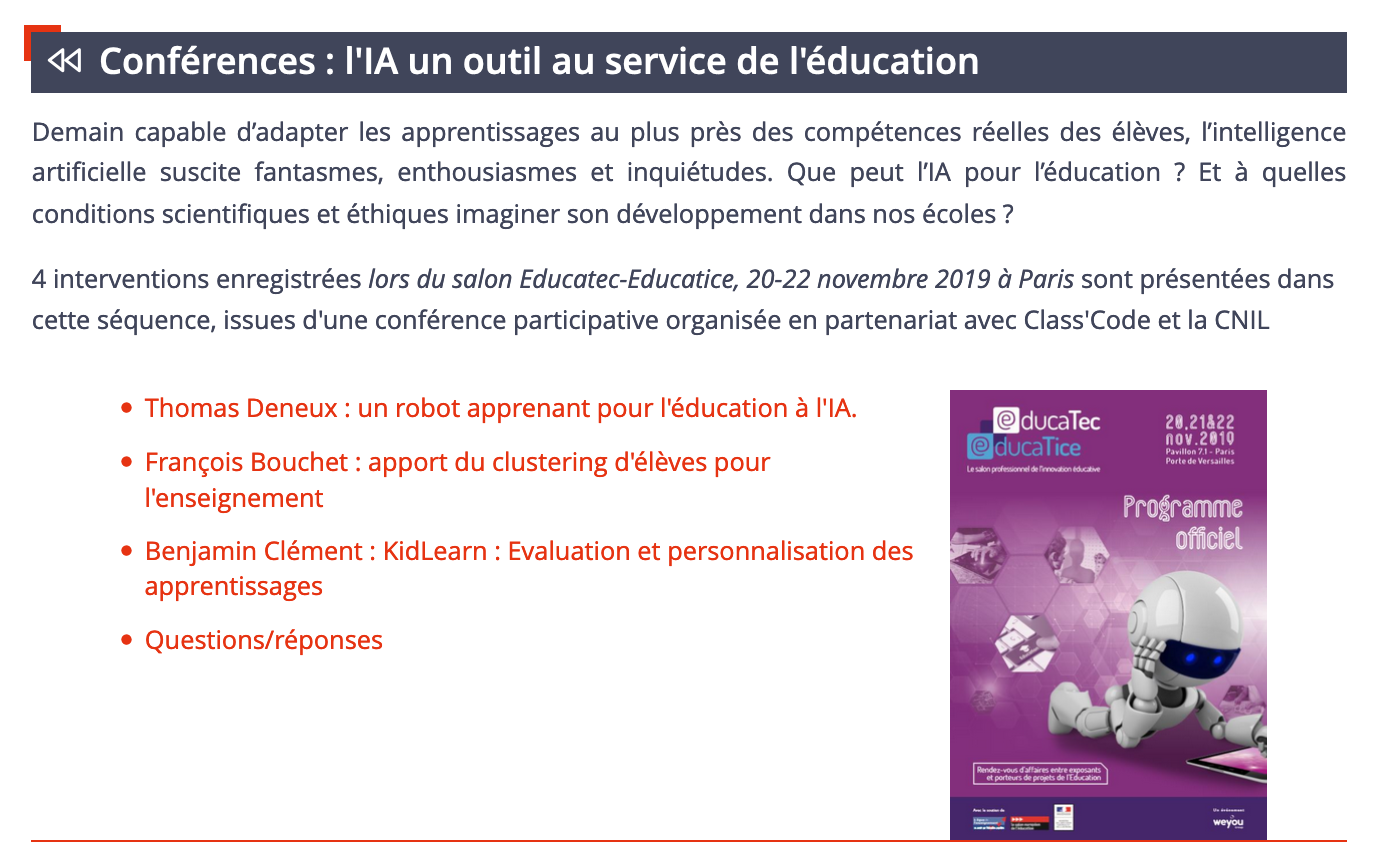
Example of AI and education conferences
|
|
2.4 To debate : AI, a tool to serve education
|
|
| Educational objectives
At the end of this sequence, learners will be able to:
- know several experiences with AI in education,
- develop critical thinking skills and discuss the contribution of AI to the field of education,
- take part in a debate on the links between AI and education.
|
|
|
2.5 Summative evaluation at the end of the module: Quiz Module 2
Educational objective: summative evaluation on the theoretical concepts seen here in Module 2. |
|
|
2.6 Summative evaluation at the end of the module: AI to play with! Questions
Educational objective: summative evaluation on the hands-on activities seen here in Module 2 |
|
Module 3. Humans and AI: Artificial Intelligence at our service ?
Objective: To understand the challenges and levers for AI to serve humans.
|
|
|
3.0 Introduction to Module 3
|
 Detailed outline of Module 3 Detailed outline of Module 3
The detailed outline gives access to the list of the 6 sequences of the module and their resources.
The resources are different types of media: videos, tutorials, texts, activity sheets, educational games, list of external resources to go further, quizzes and hands-on exercises.
Below, we have selected some of the resources of Module 3, as an example of the different types of contents of the MOOC.
|
|
3.1 To question yourself: Are humans good for the scrap yard?
|
|
| Educational objectives
At the end of this sequence, learners will be able to:
- develop a critical thinking on the statements made by the media, especially the disappearing of our jobs due to AI
- explain the Schumpeterian theory
|
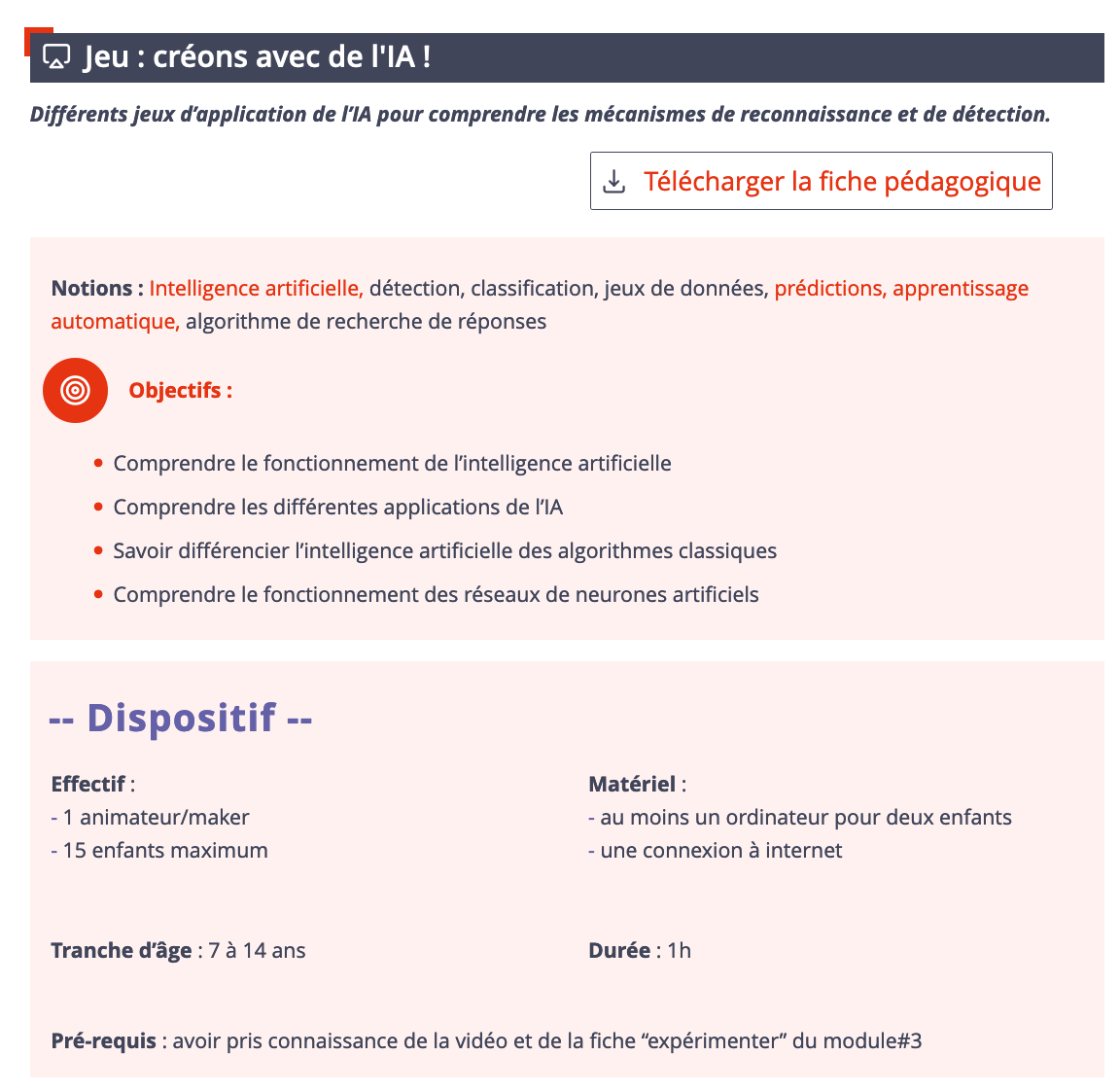
Example of an educational game sheet
|
|
3.2 To experiment: let’s create with AI
|
|
| Educational objectives
At the end of this sequence, learners will be able to:
- explain GANs: generative adversarial networks
- describe how classification algorithms work
- describe how voice assistants work
|
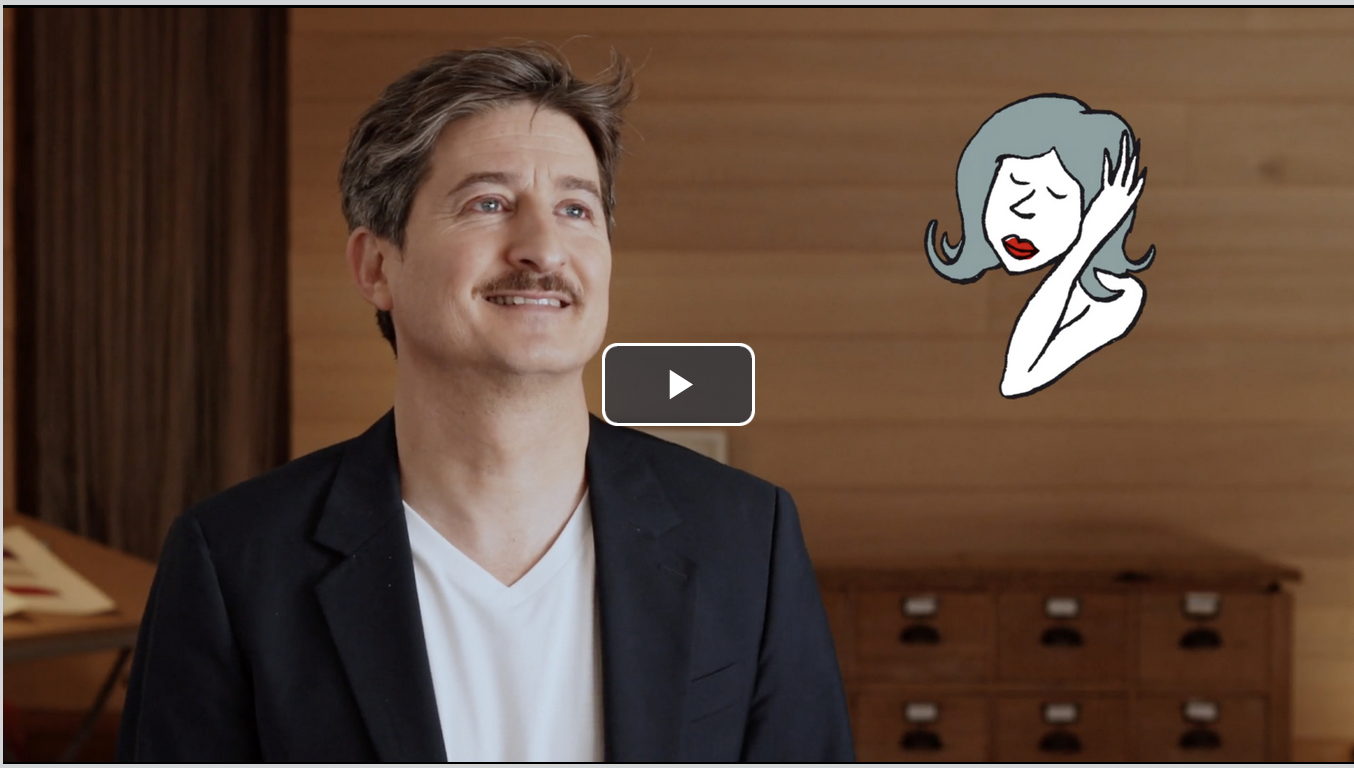
Example of in-depth video
|
|
3.3 To discover: Artificial intelligence at our service?
|
|
| Educational objectives
At the end of this sequence, learners will be able to:
- discuss the relationship between man and machine,
- distinguish the notions of imitation and invention,
- develop a critical thinking about AI as a decision aid, especially by taking into account the notion of cognitive bias.
|
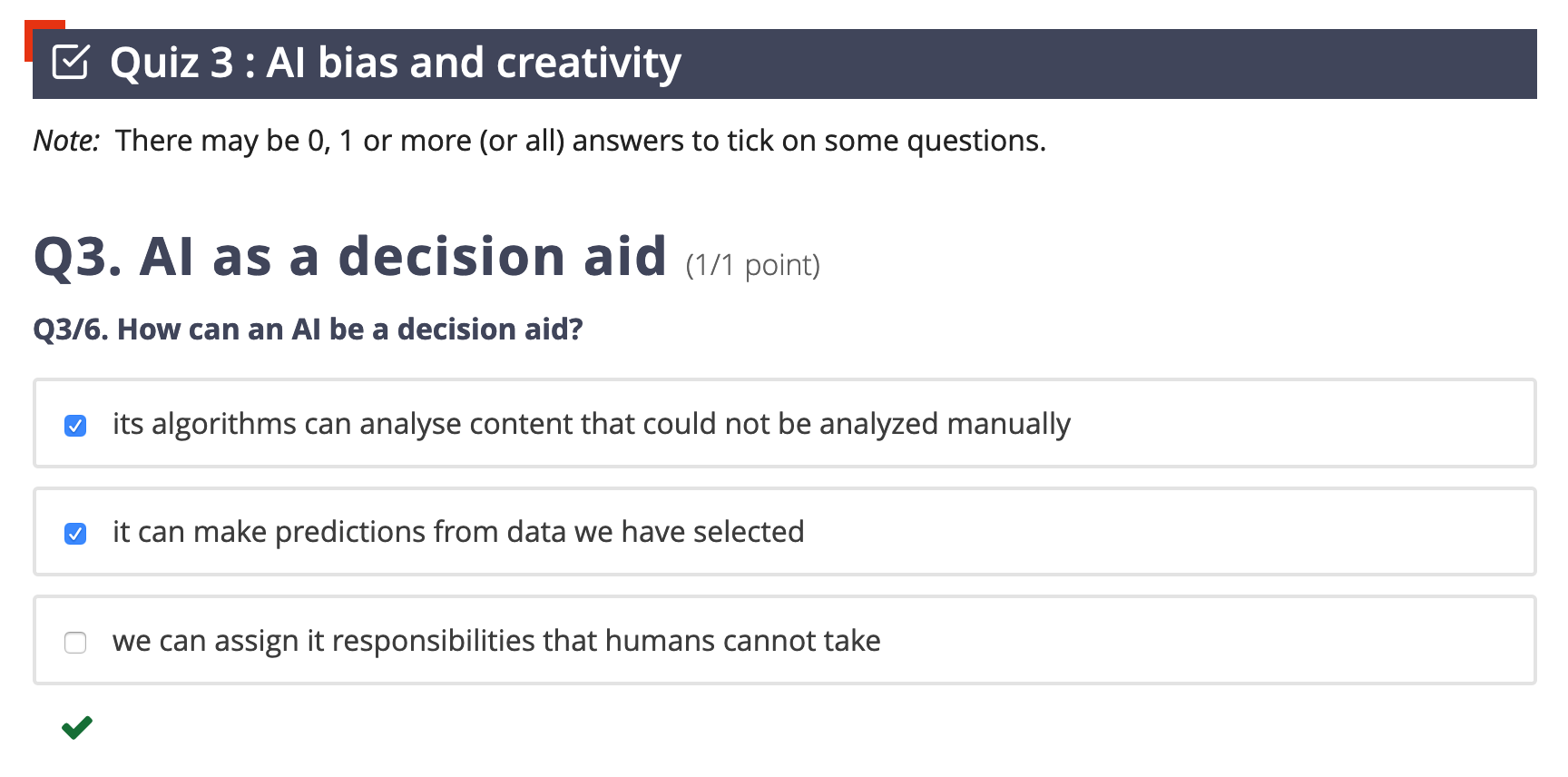
Example of quiz
|
|
3.4 To debate: AI and humans
|
|
| Educational objectives
At the end of this sequence, learners will be able to:
- Understand the challenges and levers for AI to serve humans.
|
|
|
3.5 Summative evaluation at the end of the module: Quiz Module 3
Educational objective: summative evaluation on the theoretical concepts seen here in Module 3. |
|
|
3.6 Summative evaluation at the end of the module: AI to play with! Questions
Educational objective: summative evaluation on the hands-on activities seen here in Module 3 |
|
Peer evaluation
|
Peer-reviewed hands-on exercise
|
- Peer-Reviewed IAI Mind Map
- Activity flow
- Evaluation scale
- Submit your activity
- IAI FORUM: Mind Map Activity
|
 Module 1 : Did you say AI? What is artificial intelligence?
Module 1 : Did you say AI? What is artificial intelligence?![]() Prerequisites : none
Prerequisites : none ![]() Investment time: 2h – 2h30 or more with the resources
Investment time: 2h – 2h30 or more with the resources![]() 3 videos (11’26”)
3 videos (11’26”) ![]() 5 activity sheets
5 activity sheets ![]() 1 Educational game
1 Educational game![]() 2 Quizzes/hands-on exercises
2 Quizzes/hands-on exercises ![]() Resources to go further
Resources to go further Module 2 : Boosted with AI! Machine learning and data
Module 2 : Boosted with AI! Machine learning and data![]() Prerequisites : none
Prerequisites : none ![]() Investment time: 2h – 2h30 or more with the resources
Investment time: 2h – 2h30 or more with the resources![]() 4 videos (21’39”)
4 videos (21’39”) ![]() 6 activity sheets
6 activity sheets ![]() 1 Educational game
1 Educational game![]() 2 Quizzes/hands-on exercises
2 Quizzes/hands-on exercises ![]() Resources to go further
Resources to go further Module 3 : Humans and AI: Artificial intelligence at our service?
Module 3 : Humans and AI: Artificial intelligence at our service?![]() Prerequisites : none
Prerequisites : none ![]() Investment time: 2h – 2h30 or more with the resources
Investment time: 2h – 2h30 or more with the resources![]() 3 videos (9’50”)
3 videos (9’50”) ![]() 3 activity sheets
3 activity sheets ![]() 1 Educational game
1 Educational game![]() 2 Quizzes/hands-on exercises
2 Quizzes/hands-on exercises ![]() Resources to go further
Resources to go further














